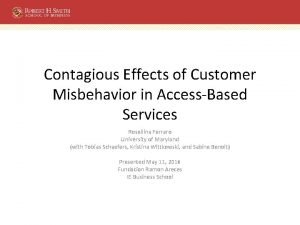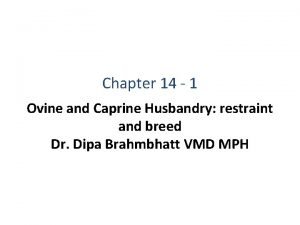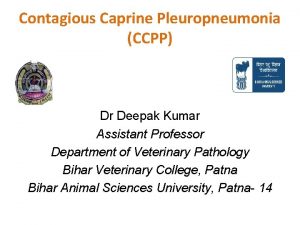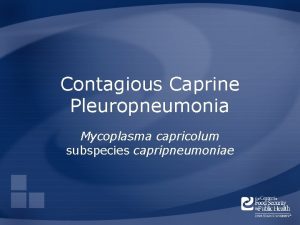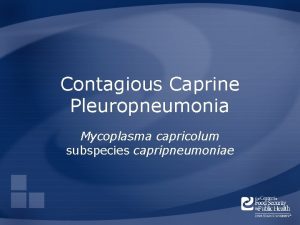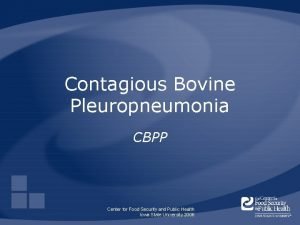CONTAGIOUS CAPRINE PLEUROPNEUMONIA UNIT 5 Anil Kumar Asst






- Slides: 6

CONTAGIOUS CAPRINE PLEUROPNEUMONIA UNIT 5 Anil Kumar Asst. Professor Dept. of VCC

Introductio n • severe contagious and frequently fatal diseases • Affects the respiratory tract • Recorded from all states of India Etiology • Mycoplasma capricolum subsp. Capripneumoniae (Mccp). • More fragile does not survive outside the animal or in the external environment for long time • Not transmissible to cattle and sheep Host Range • Goats are the primary hosts, but Sheep may be affected • In wild ruminants kept in a wildlife Transmissi on • Close contact ( inhalation of respiratory droplets). • Outbreaks often occur after heavy rains (e. g. after the monsoons in India). • Carrier animals • Infected objects, vectors, fomites and animal products.

(M. IQBAL Yatoo et al. ,

Pathogenesis: (Presented in Fig. 2) can be summarized as below: I. Inhalation is the commonest route of infection through aerosol transmission II. colonization III. ciliostasis of epithelia, serofibrinous pleuropneumonia, vasculitis, and fibrinocellular exudation IV. Mycoplasmal antigens (polysaccharides, galactan, lipoprotein) activate immune system V. stimulation of inflammatory and oxidative cascade VI. Mycoplasma capricolum subsp. capripneumoniae may also affect other organs like joints, eyes, and udder.

Figure 2. Pathogenesis of Mycoplasma capricolum subsp. capripneumoniae

Clinical findings • IP, 6 -10 Days, Mortality-100% • Anorexia, dullness, depression, nasal discharge, ab respiration, fever and painful cough • Dyspnoea, open mouth breathing, protrusion of tongue a salivation • Clinical and PM findings. Diagnosis • Isolation and identification of agent • CFT (Carrier animals) • Tube precipitation test (Very sensitive, for confirmatory di ) • Immunobinding assay (Rapid test for field diagnosis) Treatment &Control • Macrolides (Tylosin @ 10 mg/Kg, IM for 3 days )is consi be the drug of choice against Mccp • Oxytetracycline @ 15 mg/Kg IM for 6 -8 days and antibiotics like fluoroquinolone (Enrofloxacin). • Isolate the animal • Strict Hygienic measure • Vaccination: • Longley’s formalized/carbolized vaccine • Attenuated live culture vaccine @ 0. 2 ml intradermal at 15 month immunity
